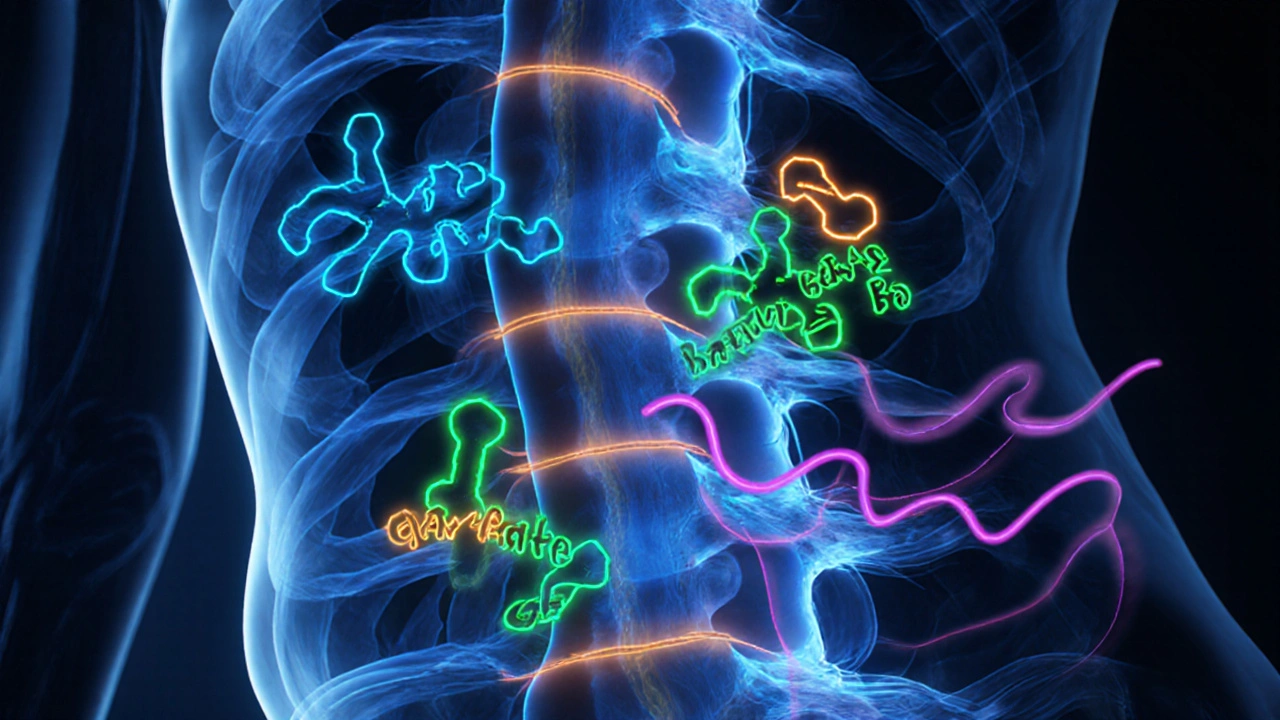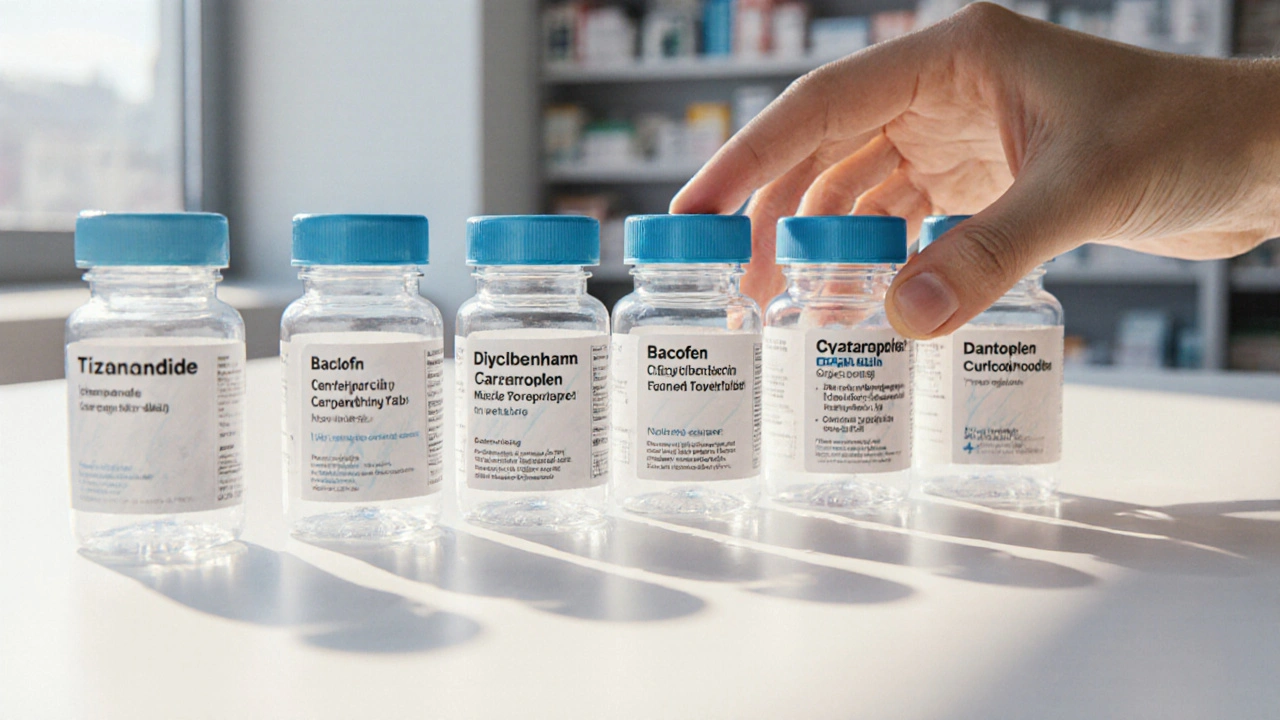Muscle Relaxant Comparison Tool
Select a muscle relaxant below to see detailed information about its properties and uses.
Tizanidine
Class: α-2 Agonist
Typical Dose: 2-8 mg 3×/day
Onset: 30-60 min
Half-life: ≈2 hours
Side Effects: Drowsiness, dry mouth, hypotension
Baclofen
Class: GABA-B Agonist
Typical Dose: 5-20 mg 3×/day
Onset: 1-2 hours
Half-life: 2-4 hours
Side Effects: Weakness, dizziness, nausea
Diazepam
Class: Benzodiazepine
Typical Dose: 2-10 mg 1-2×/day
Onset: 15-30 min
Half-life: 20-50 hours
Side Effects: Sedation, dependence, respiratory depression
Cyclobenzaprine
Class: Tricyclic Derivative
Typical Dose: 5-10 mg 3×/day
Onset: 30-60 min
Half-life: 8-20 hours
Side Effects: Dry mouth, drowsiness, anticholinergic effects
Dantrolene
Class: Direct-acting Skeletal Muscle Relaxant
Typical Dose: 25-100 mg 3×/day
Onset: 1-2 hours
Half-life: 8-12 hours
Side Effects: Liver toxicity, weakness
Carisoprodol
Class: Centrally Acting Relaxant
Typical Dose: 250-350 mg 3×/day
Onset: 30-60 min
Half-life: 2-3 hours
Side Effects: Dependence, dizziness, headache
Quick Comparison Summary
Fastest Onset: Tizanidine (30-60 min) and Diazepam (15-30 min)
Longest Half-life: Diazepam (20-50 hours)
Lowest Abuse Potential: Baclofen and Dantrolene
Best for Acute Flare-ups: Tizanidine
Best for Chronic Management: Baclofen
Peripherally Acting: Dantrolene (doesn't affect CNS)
Tizanidine is a prescription muscle relaxant often used for spasticity, but many patients wonder how it stacks up against other options. Below you’ll find a quick snapshot, a detailed breakdown of each drug’s properties, and a side‑by‑side table that makes picking the right therapy easier.
TL;DR
- Tizanidine works fast (onset 30‑60min) and is short‑acting (half‑life ~2h).
- Baclofen is the go‑to for chronic spasticity but can cause sedation.
- Diazepam offers strong anxiolysis but has a high abuse potential.
- Cyclobenzaprine is best for acute muscle strains, not long‑term spasticity.
- Dantrolene acts directly on muscle cells, useful when CNS‑active agents fail.
What is Tizanidine?
Tizanidine is an imidazoline derivative that reduces muscle tone by blocking spinal cord nerve impulses. It’s classified as a central‑acting α‑2 adrenergic agonist and is approved in the UK and US for short‑term management of spasticity caused by conditions like multiple sclerosis or spinal cord injury.
How Tizanidine Works
The drug binds to α‑2 receptors in the presynaptic neurons of the spinal cord, inhibiting the release of excitatory neurotransmitters such as glutamate and substanceP. By damping these signals, muscle stiffness drops without completely paralyzing the limb.
Key Clinical Facts
- Typical dose: Start 2mg at bedtime, titrate up to 8mg 3‑times‑daily as needed.
- Onset of action: 30‑60minutes.
- Half‑life: Approximately 2hours (extended in liver impairment).
- Common side effects: Dry mouth, drowsiness, dizziness, and hypotension.
- Contraindications: Severe liver disease, uncontrolled hypertension, and concurrent use of strong CYP1A2 inhibitors.

Common Alternatives
Below are the most frequently prescribed muscle relaxants that patients compare with Tizanidine.
Baclofen
Baclofen is a GABA‑B receptor agonist that reduces spasticity by inhibiting reflexes at the spinal level. It’s often the first‑line oral agent for chronic spasticity.
Diazepam
Diazepam belongs to the benzodiazepine class and enhances GABA‑A activity, producing muscle relaxation, anxiolysis, and sedation. Its long half‑life (20‑50hours) makes it suitable for nighttime relief.
Cyclobenzaprine
Cyclobenzaprine is a tricyclic antidepressant derivative that acts centrally to reduce muscle tone. It is approved for short‑term use (up to 3weeks) after acute musculoskeletal injuries.
Dantrolene
Dantrolene works peripherally on skeletal muscle by blocking calcium release from the sarcoplasmic reticulum. It’s the drug of choice for malignant hyperthermia and can be useful when CNS‑active agents are contraindicated.
Carisoprodol
Carisoprodol is a centrally acting relaxant that is metabolized to meprobamate, a sedative‑hypnotic. Its use is limited by abuse potential and regulatory restrictions.
Side‑by‑Side Comparison Table
| Drug | Class | Typical Dose | Onset | Half‑life | Main Side Effects | FDA Status |
|---|---|---|---|---|---|---|
| Tizanidine | α‑2 agonist | 2‑8mg 3×/day | 30‑60min | ≈2h | Drowsiness, dry mouth, hypotension | Approved |
| Baclofen | GABA‑B agonist | 5‑20mg 3×/day | 1‑2h | 2‑4h | Weakness, dizziness, nausea | Approved |
| Diazepam | Benzodiazepine | 2‑10mg 1‑2×/day | 15‑30min | 20‑50h | Sedation, dependence, respiratory depression | Approved |
| Cyclobenzaprine | Tricyclic derivative | 5‑10mg 3×/day | 30‑60min | 8‑20h | Dry mouth, drowsiness, anticholinergic effects | Approved (short‑term) |
| Dantrolene | Direct‑acting skeletal muscle relaxant | 25‑100mg 3×/day | 1‑2h | 8‑12h | Liver toxicity, weakness | Approved (malignant hyperthermia) |
| Carisoprodol | Centrally acting relaxant | 250‑350mg 3×/day | 30‑60min | 2‑3h | Dependence, dizziness, headache | Approved (restricted) |
Choosing the Right Agent for Your Situation
- Night‑time spasticity: Diazepam’s long half‑life provides smooth coverage while you sleep.
- Rapid relief for acute flare‑ups: Tizanidine’s fast onset makes it ideal for sudden stiffness.
- Long‑term management of chronic spasticity: Baclofen’s stable dosing and lower abuse risk are often preferred.
- Patients with liver disease: Avoid Tizanidine and Dantrolene; consider low‑dose Baclofen.
- When CNS‑depression must be minimized: Dantrolene works peripherally and spares the brain.
Practical Checklist Before Switching
- Review current diagnosis (multiple sclerosis, stroke, cerebral palsy, etc.).
- Check liver and kidney function labs.
- Identify any concurrent medications that use CYP1A2 or CYP3A4 pathways.
- Discuss risk of sedation or dependence with your prescriber.
- Start low, go slow - titrate the new drug while tapering the old one to avoid withdrawal.
Frequently Asked Questions
Can I take Tizanidine and Baclofen together?
Combination therapy is sometimes used for refractory spasticity, but it increases the chance of excessive drowsiness and hypotension. Only a doctor familiar with your health profile should approve it.
Why does Tizanidine cause dry mouth?
The drug’s α‑2 agonist activity reduces sympathetic outflow, which lowers salivary gland stimulation, leading to a dry mouth sensation.
Is Dantrolene safe for long‑term use?
Long‑term therapy is possible but requires regular liver‑function monitoring because hepatotoxicity is a known risk.
Which muscle relaxant has the lowest abuse potential?
Baclofen and Dantrolene have the lowest abuse potential because they do not produce the euphoric effects seen with benzodiazepines like Diazepam or with Carisoprodol.
Can I take Tizanidine if I have hypertension?
Uncontrolled hypertension is a contraindication because Tizanidine may lower blood pressure further. If your BP is well‑managed, your doctor might still prescribe it with close monitoring.
Choosing a muscle relaxant isn’t just about the fastest onset or cheapest price-it’s about matching the drug’s profile to your condition, co‑existing health issues, and lifestyle. Use the comparison table and checklist above as a starting point, then have a frank conversation with your healthcare provider to land on the safest, most effective option for you.


I am a pharmaceutical expert with over 20 years of experience in the industry. I am passionate about bringing awareness and education on the importance of medications and supplements in managing diseases. In my spare time, I love to write and share insights about the latest advancements and trends in pharmaceuticals. My goal is to make complex medical information accessible to everyone.